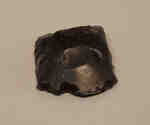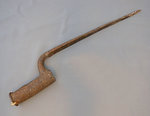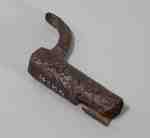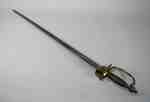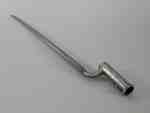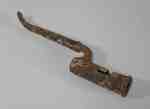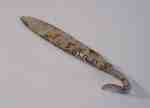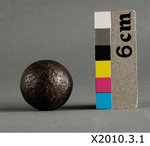Results
- An English prismatic type of flintlock that measures 3.7cm x 2.5cm. It belongs to the Servos Collection and was found at Niagara.An English prismatic type of flintlock that measures 3.7cm x 2.5cm. It …
- This is a steel spear point from a Sergeant’s spontoon in the British Army infantry from 1800 to 1820. A spontoon signified a sergeant’s rank.This is a steel spear point from a Sergeant’s spontoon in the …
- This original Brown Bess musket is an East India Pattern musket (3rd model) as it has a 39 inch barrel, a brass side plate on the opposite side of the lock and has no tail to it. The tang on the buttThis original Brown Bess musket is an East India Pattern musket (3rd …
- This original Brown Bess socket mount bayonet is vintage War of 1812. It was purchased in the Niagara area and likely has a long local provenance.This original Brown Bess socket mount bayonet is vintage War of 1812. …
- This Land/India Pattern bayonet was produced by the British Government ca. 1730-1815. This type of bayonet was used during the War of 1812. With a 17 inch blade and flat top, the bayonet gradually naThis Land/India Pattern bayonet was produced by the British Government ca. 1730-1815. …
- This is a bayonet socket with a small portion of the blade attached that was discovered in the Niagara River. A bayonet is a steel blade that is designed to fit on the muzzle of a rifle or musket barThis is a bayonet socket with a small portion of the blade …
- This bayonet, dated 1812-1814, has triangular blade. It was recovered from the Niagara River in 1980.This bayonet, dated 1812-1814, has triangular blade. It was recovered from the …
- This is a lock mechanism measuring 17.7 cm x 3.1 cm, that was made for a tower musket. This lock mechanism was converted to percussion. There are four perforations and markings include “Tower”, a triThis is a lock mechanism measuring 17.7 cm x 3.1 cm, that …
- This is an iron lock mechanism measuring 13.9 cm x 2.5 cm x 3.1cm that is a flintlock from a military pistol. There are seven perforations and markings include “1812”, “2”, and a rampant lion presentThis is an iron lock mechanism measuring 13.9 cm x 2.5 cm …
- This sword is a 1796 Pattern officer field sword. The guard is hinged and the blade has decorative sketches on it. It is believed to have belonged to an officer in the British troops. On the upper edThis sword is a 1796 Pattern officer field sword. The guard is …
- This triangular bayonet is dated circa 1812 and has the distinctive markings “S. Chambers” and “46 (Crown)” on the blade. A bayonet was designed to fit on the muzzle of a rifle or musket barrel, makiThis triangular bayonet is dated circa 1812 and has the distinctive markings …
- This bayonet would have been designed to fit on the muzzle of a rifle or musket barrel, making it into a close range weapon. There is an inscription near the socket that reads “US, F.B.” A bayonet woThis bayonet would have been designed to fit on the muzzle of …
- This is a portion of a bayonet that would have been designed to fit on the muzzle of a rifle or musket barrel, making it into a close range weapon. The socket is complete and the blade has been bent.This is a portion of a bayonet that would have been designed …
- This is a portion of a bayonet that would have been designed to fit on the muzzle of a rifle or musket barrel, making it into a close range weapon. The socket is complete. However, approximately 2/3This is a portion of a bayonet that would have been designed …
- This is a portion of a triangular bayonet that would have been designed to fit on the muzzle of a rifle or musket barrel, making it into a close range weapon. This would have been on arguably every sThis is a portion of a triangular bayonet that would have been …
- This is the tip of a triangular bayonet that would have been designed to fit on the muzzle of a rifle or musket barrel, making it into a close range weapon. This would have been on arguably every solThis is the tip of a triangular bayonet that would have been …
- This triangular bayonet is dated circa 1810-1820 and has the distinctive markings “J. Hill, (Crown) 19” on the actual blade and “110 1 G DS” on the base. A bayonet is a steel blade that is designed tThis triangular bayonet is dated circa 1810-1820 and has the distinctive markings …
- This triangular bayonet is made of iron and would have been used on a musket. A bayonet is a blade that is designed to fit on the muzzle of a rifle or musket barrel, making it into a close range weapThis triangular bayonet is made of iron and would have been used …
- Referred to "The Military Arms of Canada" by The Upper Canada Historical Arms Society and "The British Military Longarms 1715-1815' by D.W. Bailey.Referred to "The Military Arms of Canada" by The Upper Canada Historical …
- This type of ammunition, known as a grapeshot, was used in artillery during the War of 1812. A round black ball of iron with a pitted surface, this grapeshot has a circumference of 4 1/8 inches. GrapThis type of ammunition, known as a grapeshot, was used in artillery …
When selecting an individual record or object, you will move
to the website of the heritage institution that houses the item.
To return to the search or results pages, select "Back", "Results" or "New Search".
 This project was made possible with the support of the Department of Canadian Heritage
This project was made possible with the support of the Department of Canadian Heritage
through the Canadian Culture Online Strategy.
to the website of the heritage institution that houses the item.
To return to the search or results pages, select "Back", "Results" or "New Search".
 This project was made possible with the support of the Department of Canadian Heritage
This project was made possible with the support of the Department of Canadian Heritage through the Canadian Culture Online Strategy.






